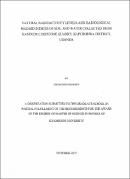| dc.description.abstract | This study was to determine the gamma ray concentration/activity due to naturally occurring
radionuclides present in soil and water from Kaserem limestone quarry area in Kapchorwa
District and the associated hazard indices. Reports from other studies associate limestone
deposits with high concentration of radionuclides and therefore data regarding these
radionuclides is useful in protecting the public from radiation exposure and minimizing risks.
In this study, fifty (50) soil samples and ten (I 0) water samples collected from the quarry area
were analyzed, with the aid of gamma spectroscopy method, using Sodium Iodide Thallium,
NaT (TI) detector. The radiation parameters included radiation equivalent activity, gamma
absorbed dose rate, annual effective dose and external and internal hazard indices in soil and
water samples from Kaserem limestone quarry. To ensure quality control, the soil samples
collected from the sites were transferred to polythene bags, labeled and double-bagged. They
were then transported in boxes whose background radiation emissions were measured with an
identifier while water samples were put in plastic water bottles and sealed before
transportation to the laboratory. Naturally occurring radionuclides (NORM) present in soil
and water samples were identified. The specific activity concentrations of 226Ra, 232Th, 238U
and 4°K in soil samples are: 75.71 Bq kg·\ 77.01 Bq kg·', 41.07 Bq kg· ' and 536.9 Bq kg·',
respectively. These natural activity values were higher than the maximum permissible world
average values; hence this area should be considered high background radiation area (HBRA)
and the activity concentration of 226Ra, 232Th, 238U and 4°K in water samples was 104.18 Bq
kg· ', 16.58 Bq kg· ', 19.27 Bq kg·' and 22.73 Bq kg·', respectively. The average absorbed dose
rates were found to be 106.39 nGy h· ' for soil samples, which is about 2 times the world
average of 60 nGy h· ' ; While for water samples it was 56.44 nGy h· ' which is similar to the
world average absorbed dose rate of 55 nGy h- 1
•
Assuming 33% occupancy factor, the annual average effective dose rates (AED) were
calculated for human exposure to gamma radiations from the radionuclides in soil and it was
found to be 0.31 mSv y"1 which is below International Commission on Radiation Protection
(ICRP) limit of 1 mSv y·' for exposure to members of the general public, while the value for
water samples was 0.18 mSv y"1 which was above the reference value of0.12 mSv y" 1
. While
the mean radium equivalent values for soil and water samples were: 227.17 Bq kg· ' and | en_US |

